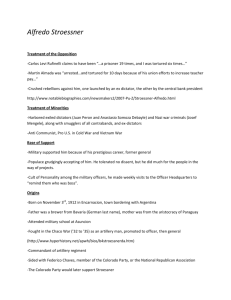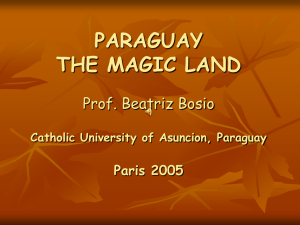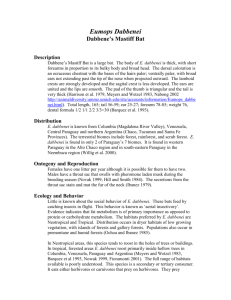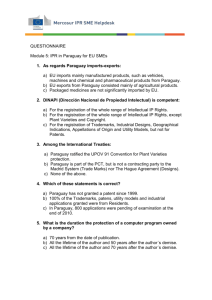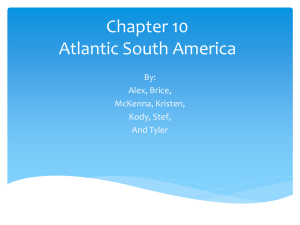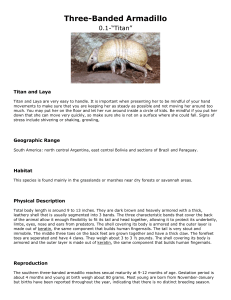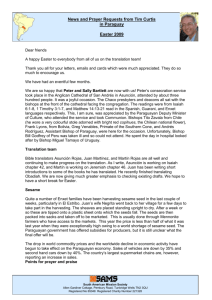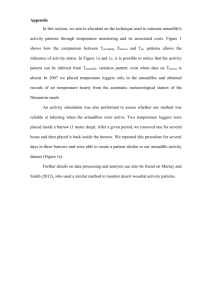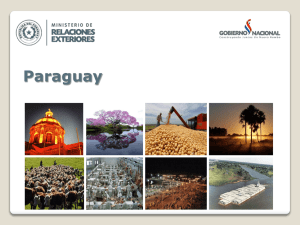SOUTHERN LONG-NOSED ARMADILLO Dasypus hybridus
advertisement
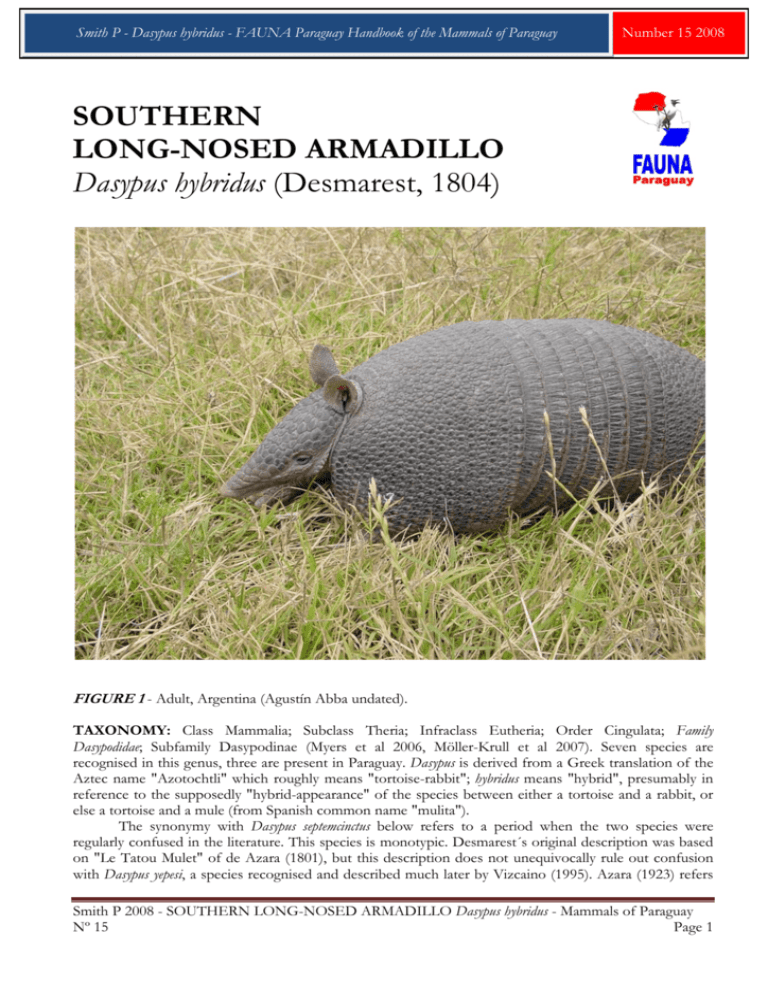
Smith P - Dasypus hybridus - FAUNA Paraguay Handbook of the Mammals of Paraguay Number 15 2008 SOUTHERN LONG-NOSED ARMADILLO Dasypus hybridus (Desmarest, 1804) FIGURE 1 - Adult, Argentina (Agustín Abba undated). TAXONOMY: Class Mammalia; Subclass Theria; Infraclass Eutheria; Order Cingulata; Family Dasypodidae; Subfamily Dasypodinae (Myers et al 2006, Möller-Krull et al 2007). Seven species are recognised in this genus, three are present in Paraguay. Dasypus is derived from a Greek translation of the Aztec name "Azotochtli" which roughly means "tortoise-rabbit"; hybridus means "hybrid", presumably in reference to the supposedly "hybrid-appearance" of the species between either a tortoise and a rabbit, or else a tortoise and a mule (from Spanish common name "mulita"). The synonymy with Dasypus septemcinctus below refers to a period when the two species were regularly confused in the literature. This species is monotypic. Desmarest´s original description was based on "Le Tatou Mulet" of de Azara (1801), but this description does not unequivocally rule out confusion with Dasypus yepesi, a species recognised and described much later by Vizcaino (1995). Azara (1923) refers Smith P 2008 - SOUTHERN LONG-NOSED ARMADILLO Dasypus hybridus - Mammals of Paraguay Nº 15 Page 1 Smith P - Dasypus hybridus - FAUNA Paraguay Handbook of the Mammals of Paraguay Number 15 2008 to only two Dasypus armadillos in his treatise, one tatuejo oscuro is clearly Dasypus novemcinctus, the other tatuejo-mulita has traditionally been associated to this species. The description of tatuejo-mulita refers to no more than 7 bands and no less than 5, short legs and a vague description of size "no more than 11 inches without the tail, which reaches six and four". Synonyms adapted from Gardner (2007). lor[icatus] hybridus Desmarest 1804:28. No type locality given. Based on de Azara (1801). Restricted to San Ignacio, Misiones, Paraguay by Cabrera (1958). [Dasypus] hybridus G.Fischer 1814:126. Name combination. [Dasypus] auritus Illiger 1815:108. Nomen nudum. T[atus] auritus Olfers 1818:221. Type locality "Paraguay". Based on de Azara (1801). Tatusia hybridus Lesson 1827:311. Name combination. T[atusia] hybrida Turner 1853:213. Corrected gender. Praopus hybridus Burmeister 1861:428. Name combination. Tatu hybridus Lahille 1899:203. Name combination. [Tatusia (Muletia)] hybrida Trouessart 1898:1140. Name combination. [Tatusia (Muletia)] hybridus Trouessart 1905:814. Name combination. Muletia hybrida A.Miranda-Ribeiro 1914:46. Name combination. D[asypus] Brevi-cauda Larrañaga 1923:344. Type locality not given but Uruguay implied. Based on de Azara (1802). Dasypus hibridus Azevedo, El Achkar, Martins & Ximénez 1982:95. Incorrect spelling. ENGLISH COMMON NAMES: Southern Long-nosed Armadillo (Wilson & Cole 2000, Superina & Aguiar 2006, Gardner 2007), Southern Lesser Long-nosed Armadillo (Redford & Eisenberg 1992). SPANISH COMMON NAMES: Mulita orejuda (Redford & Eisenberg 1992), Mulita (González 2001), Mulita pampeana (Chebez 2001), Mulita chica (Chebez 2001). The Spanish name "Mulita" or "little mule" stems from the long, donkey-like ears present in members of this genus. Despite the name "orejuda" (meaning big ears) this species has proportionately the shortest ears of the Paraguayan Dasypus. "Mulita chica" (little Mulita) is in direct comparison to the Nine-banded Armadillo, the only Dasypus sympatric with it over much of its Argentinean range. "Mulita pampeana" reflects its preference for grassland-type habitats such as those of the Argentinean pampas. GUARANÍ COMMON NAMES: Tatu mburica MPA (Hamlett 1939). "Tatu mburica" means "Donkey armadillo" in reference to the long ears of the species. DESCRIPTION: "Long-nosed" Armadillos have a broad, depressed body, an obtusely-pointed rostrum, long, pointed ears and short legs. The carapace consists of two immobile plates, the scapular and pelvic shields separated by 6 or 7 movable bands connected to each other by a fold of hairless skin. The carapace is mostly dull brownish-grey to brownish-yellow, with a very light covering of hair. Frequently there is a paler yellowish lateral line that is more visible in some individuals than others and usually reduced to small triangular "teeth" on that lateral scutes of the movable bands. The scales of the anterior edge of the movable bands are darker than the rest of the dorsum. Scutes on the movable bands are triangular in shape, but those on the main plates are rounded. The number of scutes present on the fourth movable band varies from 50 to 62, with a mean of 54 (Diaz & Barquez 2002, Hamlett 1939). The head is thin and triangular with a sloping forehead and long, mobile ears with rounded tips that are not separated by armour at the base. The tail is short compared to other Dasypus (60-70% body length), broad at the base and narrowing towards the tip. There are four toes on the forefeet (characteristic of the Subfamily Dasypodinae), the middle two much the longest, and five on the hindfeet. The underside is naked and pink-grey. Females possess four mammae. SKELETAL CHARACTERISTICS: Steeply descending frontal bone. Vizcaino et al (1999) give the following ulnar dimensions (n=6): Ulnar Length 52.9mm (+/-2.7); Olecranon Length 20.6mm (+/-1.2). The trend towards fossoriality is correlated with relative development of the olecranon process, and the ratio of the ulnar length to olecranon length is the Index of Fossorial Ability. An IFE above 0.70 is considered indicative of a highly fossorial species and one below 0.55 of a cursorial species. This species has an IFE of 0.64 (+/-0.03). DENTAL CHARACTERISTICS: Armadillos lack true teeth. "Long-nosed" armadillos have singlerooted, peg-like teeth that lack enamel. Dental formula 6/8=28. Smith P 2008 - SOUTHERN LONG-NOSED ARMADILLO Dasypus hybridus - Mammals of Paraguay Nº 15 Page 2 Smith P - Dasypus hybridus - FAUNA Paraguay Handbook of the Mammals of Paraguay Number 15 2008 GENETIC CHARACTERISTICS: 2n=64. FN=76. (Gardner 2007). The SC (synaptonemal complex) karyotype shows 31 autosomal SCs and the XY pair. The X chromosome is submetacentric and the extremely acrocentric Y chromosome is one of the two shortest. The absolute length of the Y axis is 4.0 mm (+/-0.8; n=11). The ratio between the X axis and Y axis is X/Y = 4.3 (n=3) in early pachytene. The length of the XY pair is 4.1 mm (+/-0.6). (Sciurano et al 2003). Redi et al (2005) gives the genome size as 4.89pg (+/-0.34) or 4782 Mbp. TRACKS AND SIGNS: Dasypus prints can be distinguished from those of other armadillos by their long, pointed toes with four toes on the forefoot and five on the hindfoot. However they generally leave the impression of only the two central toes on the forefeet (though sometimes the outer toe is also visible) and three central toes on the hindfeet. Given a full print, the hindfoot has a pointed heel with three long, somewhat pointed central toes and two, much shorter, outer toes set well back towards the heel. The forefoot has the inner toe much reduced and it rarely leaves an impression. EXTERNAL MEASUREMENTS: The "intermediate" "long-nosed armadillo" in Paraguay. TL: 45.95cm (39.7-49.8cm); TA: 16.84cm (13.2-19.1cm); FT: 6.73cm (5.5-7.3cm); EA: 2.51cm (2.3-2.8cm); WT: 1.5kg (1.09-2.04kg). (Redford & Eisenberg 1992, González 2001). Hamlett (1939) gives the following mean measurements of preserved specimens for this species Head 7.5cm; Body: 24cm; TA: 15.7cm; EA: 2.33cm (2-3.5cm). SIMILAR SPECIES: This species is intermediate in size between the other two "long-nosed armadillos" in Paraguay and is characterised by its shorter ears (25-30% of head length) and tail (67-70% of body length) which give it a distinctive appearance. It can be immediately separated from the much larger and more widespread Dasypus novemcinctus by the number of bands - 6 or 7 as opposed to eight or nine (usually 8) in that species (Hamlett 1939). Note also that the tail length of D. novemcinctus is equal to or greater than the body length and that the ears are much longer (40-50% of head length). Dasypus novemcinctus has 7 to 9 teeth in the upper jaw, typically 8, compared to 6 in this species. Using the fourth movable band as a standard, Hamlett (1939) noted that this species has a mean of 54 scutes whereas D. novemcinctus has a mean of 60 scutes. Furthermore this species prefers open country habitats, whereas D. novemcinctus is more often associated with forested areas. The other open-country Dasypus is the slightly smaller and darker D.septemcinctus, but it is unclear exactly how much their ranges overlap in Paraguay or even if they do at all. D.septemcinctus shares the number of movable bands and number of teeth in the upper jaw with this species, but is longer-eared (4050% head length) and longer tailed (80-100% body length). D.septemcinctus has a mean of 48.4 scutes along the fourth movable band (Hamlett 1939). DISTRIBUTION: The most southerly of the Dasypus armadillos, with an extensive range from Argentina through Uruguay in the east to Brazil, probably as far north as Matto Grosso do Sul. However the species is apparently absent or un-recorded in many areas of the vast range and the maps given by Redford & Eisenberg (1992) incorrectly exaggerate the extent of the species distribution in Brazil and Argentina. In Argentina it is found west only as far as eastern Provincia Cordoba and south to Provincia Buenos Aires, with records for the Andean foothills being the result of misidentification. Though it has been cited as present in Provincia Misiones, Argentina there is apparently no confirmation of the species occurrence there (Chebez 2001) and there are only two records with an imprecise locality from Jujuy both collected in the 1930s (Diaz & Barquez 2002). In Uruguay it occurs throughout the country and there are specimen records from all departments except Montevideo. (Daniel Hernández in litt.). In Paraguay the precise range of this species is uncertain because of confusion over the species identity and a paucity of specimen records. A species of undisturbed grasslands that does not tolerate human alteration of habitat, its distribution may have been naturally limited in Paraguay by the expanse of the Atlantic Forest and further reduced by human activity. Azara notes that the species does not "pass north of 26 and a half, but is found to the south" reflecting a more southerly distribution, however today that represents the area of the country with the greatest conversion of grasslands to agriculture and there are no modern records from that region. Though the type locality of the species is in Paraguay, the only recent record we are aware of is a male specimen in the Museo Nacional de Historia Natural (MNHNP 3365) from Estancia Rama III, Departamento Candindeyú, collected on 7 December 2006, this specimen showing some damage to the tail tip. Neris et al (2001) mapped both this species and that of the SevenSmith P 2008 - SOUTHERN LONG-NOSED ARMADILLO Dasypus hybridus - Mammals of Paraguay Nº 15 Page 3 Smith P - Dasypus hybridus - FAUNA Paraguay Handbook of the Mammals of Paraguay Number 15 2008 banded together, reflecting the lack of clarity in the range of the two species and apparently greatly overestimating the distribution of both. HABITAT: This species is typical of native, undisturbed grasslands and is unable to tolerate human interference, rapidly disappearing from agricultural areas (Edentate Specialist Group 2004, Abba et al 2007). Abba & Cassini (2010) note that they prefer areas with humic soils in Provincia Buenos Aires, Argentina. Anacleto et al (2006) used the genetic algorithm program GARP to predict the species distribution in Brazil, with results suggesting this species would occur in Atlantic Forest and Pampas biomes in that country. ALIMENTATION: Constantly on the move, this species feeds in much the same way as the Ninebanded Armadillo, moving rapidly and snuffling constantly when digging shallow foraging holes. In Uruguay they have been recorded as digging into ant and termite nests. One stomach contained mostly ants and termites as well as Orthoptera, Lepidoptera, other invertebrates and the remains of a small rodent, though it is unclear if that individual was hunted or scavenged. (Redford & Eisenberg 1992). Abba & Cassini (2010) found the species to be strongly myrmecophagous, with almost half the matter in 33 fecal samples being Formicidae. Leaves, seeds, Coleoptera and Blattaria were less significantly represented. The food niche breadth was 0.27 on the Levin Index. Captive individuals were maintained on a daily diet of 100g high protein (26%) commercial puppy food soaked in water a day before presentation, 50mg powdered milk, water and 30g mince meat. This was supplemented with vitamins and minerals and an egg was added twice a week.(Ferrari et al 1997). REPRODUCTIVE BIOLOGY: Ferrari et al (1997) published the first data on captive breeding of the species. They noted that the breeding cycle begins in March in Buenos Aires with the first copulations, with births in October and November. The male was not removed from the enclosure as it posed no threat to the offspring. Embryo counts range from 7 to 12, with 8 the most common number (Redford & Eisenberg 1992, Adamoli et al 2001). GENERAL BEHAVIOUR: Solitary and active during the day and at night, though often more nocturnal in summer to avoid the heat of the day (González 2001). Captive individuals in Buenos Aires, Argentina were observed to be most active at midday during winter and in the afternoon during summer, remaining inactive during the hottest temperatures (Ferrari et al 1997). Abba et al (2009) captured this species mainly during the day in Buenos Aires Province. Abba & Cassini (2010) found a significant difference in the capture rate of animals outside of their burrows between the colder seasons (7 captures) and the warmer seasons (34 captures), concluding that the species is less active in the winter than in the summer, at least in the temperate latitudes that represent the southern extremes of its range. They speculated that this may be linked to their specialised diet. Refuges Abba et al (2007) found this species to be specialised in its burrow locations in Provincia Buenos Aires, Argentina, preferring to locate the burrows in undisturbed grassland habitats. The main function of burrows is to provide refuge from predators and to provide shelter for resting (González et al 2001). Burrows are located only in open areas in grasslands and not in forested habitats. Typically they are around 1-2m long with a single entrance less than 25cm in diameter and dry grass may be accumulated at the entrance (González 2001). In Uruguay burrows were most frequently located in open areas with sandy soils on flat or sloping ground (89.3%), in ravines (5.1%) or amongst rocks (5.6%). (González et al 2001). Of the 20 excavated burrows studied the mean dimensions where length 118.8cm (+/-105.69cm), width 15.3cm (+/-5.15cm) and depth 43.3cm (+/-10.22cm). These burrows were approximately cylindrical with a conical end, consisting of a single tunnel without branches and in 6 cases terminating in a chamber 25.6cm (+/-6.19cm) wide x 35.2cm deep (+/-8.49cm). Burrows were randomly situated but the entrance avoided facing south, the direction of prevailing winds in the study area. The considerable difference in burrow lengths may be related to differences in usage. Burrows providing refuge from predators would be needed year round, and these would be likely to be more numerous, shorter burrows which are rapidly constructed and fulfil the function of providing safe haven. The qualities of resting burrows will likely vary through the year given the difference in summer and winter temperatures in Uruguay. During the cold winters longer and deeper burrows which maintain a higher temperature than the outside air help the animal thermoregulate. (González et al 2001). Defensive Behaviour When pursued they run rapidly and erratically towards their burrow. Smith P 2008 - SOUTHERN LONG-NOSED ARMADILLO Dasypus hybridus - Mammals of Paraguay Nº 15 Page 4 Smith P - Dasypus hybridus - FAUNA Paraguay Handbook of the Mammals of Paraguay Number 15 2008 Enemies In northeastern Buenos Aires Province, Abba et al (2009) found this species to be considerably less abundant in areas where dogs where present than in areas where they were absent. Parasites Navone (1990) recorded the following nematodes in this species in the Argentinean Pampas: Aspidodera fasciata (Aspidoderidae), Pterygodermatites chaetophracti (Rictularidae) and Mazzia bialata (Cosmocercidae) and Aspidodera fasciata (Aspidoderidae) in the Espinal region. Pterygodermatites chaetophracti (Rictularidae) and Mazzia bialata (Cosmocercidae) were also recorded in the Paranaense region. Vicente et al (1997) list the following nematodes for this species from Brazil in their catalogue: Moennigia lutzi (Travassos, 1935); Delicata cameroni Travassos, 1935; Macielia macieli (Travassos, 1915) Travassos, 1935. Ezquiaga et al (2008) recorded the flea Tunga penetrans (Siphanoptera) on 7.7% of specimens of this species captured in northeastern Provincia Buenos Aires. Mauri & Navone (1993) noted Rhophalopsyllus lutzi cleophontis (Siphanoptera) on this species in Provincia Corrientes. In the collections they examined Guglielmone et al (2003) noted one Ixodid tick Amblyomma pseudoconcolor associated with this species. Based on distribution and prevalence in other armadillos they suggested that Dasypus is not a preferred host for this species. Mauri & Navone (1993) added Androlaelaps fahrenholzi (Laelapidae) from Provincia Buenos Aires. Physiology Estecondo & Casanave (2010) describe the morphology of the dorsal surface of the tongue of this species using a scanning electron microscope and Codón et al (2003) the histology of the salivary glands. Codón & Casanave (2000) describe the morphology of the ovaries in this species. Ferrari et al (2000) studied the ultrastructure of the olfactory mucosa of this species in comparison with that of Chaetophractus villosus. Cetica et al (2005) described the morphology of the female reproductive tract and found it to have disk-shaped ovaries with the cortex occupying almost the entire organ and a single oocyte in each follicle. The uterus was simple and pear-shaped, and the uterine cervix is long as in all armadillos. A urogenital sinus is present in place of a true vagina. The authors recognised three morphological groups amongst the Dasypodids studied, with Dasypus armadillos forming their own group amongst the studied genera. Adamoli et al (2001) described the morphology of the placenta, it being pear-shaped, filling threequarters of the uterine surface and homogeneously villosus across the maternal face but smooth on the fetal face where the umbilical cords inserted. No trace of a yolk sac was present. Histological analysis revealed it to be a hemochorial type placenta. VOCALISATIONS: Snuffling noises are given when foraging. HUMAN IMPACT: Hunted throughout its range as a source of food. It is hunted in Uruguay and has been used in the fabrication of crafts since Prehispanic times, though only during the 20th Century did the pressure on the species begin to tell (Fallabrino & Castañeira 2006). Abba et al (2007) note that the species is extremely uncommon in areas close to human populations and in areas where there are domestic dogs. No specific information is available for Paraguay where the species is extremely poorly known, but it is undoubtedly hunted for food and it is doubtful whether hunters would consciously distinguish this species from other Dasypus. CONSERVATION STATUS: The Southern Long-nosed Armadillo is considered Lowest Risk, near threatened by the IUCN (Abba & Superina 2010), see http://www.iucnredlist.org/search/details.php/6288/all for the latest assessment of the species. The Centro de Datos de Conservación in Paraguay do not list the species and nor is it listed by CITES. The species has undergone a decline of at least 10-25% in the last 10 years and is on the verge of being upgraded to vulnerable. The last conservation assessment of the species in Paraguay considered it Least Concern (Morales 2007), but Smith (in press) highlights the limited knowledge of the species´ distribution in the country and considers it to be data deficient at the national level, with the note that if more was known about its range it would qualify for a much higher threat category. This species is more susceptible to human interference than other Dasypus and has disappeared over large areas of its range in Argentina as a result of the expanse of agriculture. It has undergone a notable decline and range contraction over the last thirty years as a result of hunting and habitat destruction and few of the areas with viable populations of the species are under official protection. Conversion of natural grasslands to agriculture in Paraguay has been equally rapid and the Smith P 2008 - SOUTHERN LONG-NOSED ARMADILLO Dasypus hybridus - Mammals of Paraguay Nº 15 Page 5 Smith P - Dasypus hybridus - FAUNA Paraguay Handbook of the Mammals of Paraguay Number 15 2008 species has undoubtedly undergone a similarly silent decline in the country. It is considered a conservation priority in Uruguay (Abba & Superina 2010). REFERENCES: Abba AM, Cassini MH 2008 - Los Xenartros (Mamalia: Xenarthra) del Museo Argentino de Ciencias Naturales Bernardino Rivadavia y del Museo de La Plata (Argentina) - Contribuciones del MACN 4: p5-37. Abba AM, Cassini MH 2010 - Ecological Differences Between Two Sympatric Species of Armadillos (Xenarthra, Mammalia) in a Temperate Region of Argentina - Acta Theriologica 55: p35-44. Abba AM, Superina M 2010 - The 2009/2010 Armadillo Red List Assessment - Edentata 11: p135-184. Abba AM, Vizcaino SF, Cassini SH 2007 - Effects of Land Use on the Distribution of Three Species of Armadillos in the Argentinean Pampas - Journal of Mammalogy 88: p502-507. Abba AM, Vizcaíno SF, Cassini MH 2009 - Eto-Ecología y Conservación de Tres Especies de Armadillos (Dasypus hybridus, Chaetophractus villosus y C.vellerosus) en el Noreste de la Provincia de Buenos Aires, Argentina - Edentata 8-10: p41-47. Adamoli VC, Cetica PD, Merani MS, Solari AJ 2001 - Comparative Morphologic Placental Types in Dasypodidae (Chaetophractus villosus, Cabassous chacoensis, Tolypeutes matacus and Dasypus hybridus) - Biocell 25: p17-22. Anacleto TCS, Diniz-Filho JAF, Vital MVC 2006 - Estimating Potential Geographic Ranges of Armadillos (Xenarthra, Dasypodidae) in Brazil Under Niche-based Models - Mammalia 70: p202-213. Azara F de 1801 - Essais sur l´Histoire Naturelle des Quadrupèdes de la Province du Paraguay - Charles Pougens, Paris. Azara F de 1802 - Apuntamientos para la Historia Natural de los Quadrúpedos del Paraguay y Rio de la Plata - La Imprenta de la Viuda de Ibarra, Madrid. Azara F de 1923 - Viajes por la America Meridional - Calpe, Madrid. Azevedo TR de, El Achkar D, Martins M de, Ximénez A 1982 - Lista Sistemática dos Mamíferos de Santa Catarina Conservados nos Principais Museus do Estado - Revista Nordest. Biol. 5: p93-104. Burmeister H 1861 - Reise Durch die La Plata-Staaten, mit Besonderer Rücksicht auf die Physische Beschaffenheit und den Culturzustand der Argentinischen Republik Ausgeführt in den Jahren 1857, 1858, 1859 und 1860 - HW Schmidt, Halle. Cabrera A 1958 - Catálogo de los Mamíferos de América del Sur - Revista Museo Aregntino de Ciencias Naturales Bernadino Rivadavia Zoology 4: p1-307. Cetica PD, Marcos HJA, Merani MS 2005 - Morphology of Female Genital Tracts in Dasypodidae (Xenarthra: Mammalia): A Comparative Survey - Zoomorphology 124: p57-65. Chebez JC 2001 - Fauna Misionera - LOLA, Buenos Aires. Cimari AV 1996 - Mamíferos de Santa Catarina - FATMA, Florianópolis. Codón SM, Casanave EB 2000 - Comparative Morphology of the Ovaries of Three Species of Dasypodidae (Mammalia, Xenarthra) - Revista Chilena de Anatomía 18: p251-257. Codón SM, Estecondo S, Casanave EB 2003 - Histological Study of the Salivary Glands in Dasypus hybridus (Mammalia, Dasypodidae) - International Journal of Morphology 21: p199-204. Desmarest AG 1804 - Tableau Méthodique des Mammifères in Nouveau Dictionnaire d´Histoire Naturelle, Appliquée aux Arts, Principalement à l`Agriculture, à l`Économie Rurale et Domestique: Par une Société de Naturalistes et d`Agriculteurs: Avec des Figures Tirées des Trois Règnes de la Nature Deterville Vol 24, Paris. Díaz MM, Barquez RM 2002 - Los Mamíferos del Jujuy, Argentina - LOLA, Buenos Aires. Edentate Specialist Group 2004 - The 2004 Edentate Species Assessment Workshop - Edentata 6: p1-26. Estecondo S, Casanave EB 2010 - Scanning Electron Microscopy Study of the Dorsal Surface of the Tongue in Dasypus hybridus (Mammalia, Xenarthra, Dasypodidae) - International Journal of Morphology 28: p379-384. Ezquiaga MC, Lareschi M, Abba AM, Navone GT 2008 - Nuevos Registros de Pulgas (Siphonaptera) Parásitas de Dasipódidos (Mammalia: Xenarthra) en el Noroeste de la Provincia de Buenos Aires, Argentina - Mastozoologia Neotropical 15: 193-196. Fallabrino A, Castañeira E 2006 - Situación de los Edentados en Uruguay - Edentata 7: p1-3. Smith P 2008 - SOUTHERN LONG-NOSED ARMADILLO Dasypus hybridus - Mammals of Paraguay Nº 15 Page 6 Smith P - Dasypus hybridus - FAUNA Paraguay Handbook of the Mammals of Paraguay Number 15 2008 Ferrari CC, Carmanchahi PD, Aldana Marcos HJ, Affanni JM 2000 - Ultrastructural Characterisation of the Olfactory Mucosa of the Armadillo Dasypus hybridus (Dasypodidae, Xenarthra) - Journal of Anatomy 196: p269-278. Ferrari CC, Carmanchahi PD, Bolkovic ML, Affanni JM 1997 - Breeding in Captivity of the Southern Lesser Long-nosed Armadillo Dasypus hybridus - Zoocriaderos 2: p1-5. Fischer G 1814 - Zoognosia Tabulis Synopticis Illustrata: Volumen Tertium. Quadrupedum Reliquorum, Cetorum et Monotrymatum Descriptionen Continens - Nicolai Sergeidis Vsevolozsky, Mosquae. Gardner AL 2007 - Mammals of South America Volume 1: Marsupials, Xenarthrans, Shrews and Bats University of Chicago Press. González EM 2001 - Guía de Campo de los Mamíferos de Uruguay: Introducción al Estudio de los Mamíferos - Vida Silvestre, Montevideo. González EM, Soutollo A, Altuna CA 2001 - The Burrow of Dasypus hybridus (Cingulata: Dasypodidae) Acta Theriologica 46: p53-59. Guglielmone AA, Estrada-Peña A, Luciani CA, Mangold AJ, Keirans JE 2003 - Hosts and Distribution of Amblyomma auricularium (Conil 1878) and Amblyomma pseudoconcolor Argaão, 1908 (Acari: Ixodidae) - Experimental and Applied Acarolgy 29: p131-139. Hamlett GWD 1939 - Identity of Dasypus septemcinctus Linnaeus with Notes on Some Related Species Journal of Mammalogy 20: p328-336. Illiger JKW 1815 - Ueberblick der Säugthiere nach Ihrer Vertheilung Über die Welttheile - Abhandl. König. Akad. Wiss. Berlin 1804-18811: p39-159. Lahille F 1899 - Essayo Sobre la Distribución Geográfica de los Mamíferos en la República Argentina p165-206 in Bery C, Bahía MB, Reyes FB eds Trabajos de la Segunda Sección (Ciencias Físico-Químicas y Naturales), Primero Reunión del Congreso Científico Latino Americano - Sociedad Científica Argentina, Buenos Aires. Larrañaga DA 1923 - Escritos - Instituto Histórico y Geográfico del Uruguay, Montevideo. Lesson RP 1827 - Manuel de Mammalogie ou Histoire Naturelle des Mammifères - Roret, Paris. Mauri R, Navone GT 1993 - Ectoparásitos (Siphanoptera y Acari) más Comunes en Dasypodidae (Mammalia: Xenarthra) de la Republica Argentina - Revista de la Sociedad Entomológica de Argentina 52: p121122. Mirando-Ribeiro A 1914 - Mamíferos- Cebidae, Hapalidae, Vespertilionidae, Emballonuridae, Phyllostomatidae, Felidae, Mustelidae, Canidae, Procyonidae, Tapyridae, Suidae, Cervidae, Sciuridae, Muridae, Octodontidae, Coenduidae, Dasyproctidae, Caviidae e Leporidae; Platanistidae; Bradypodidae, Myrmecophagidae, Dasypodidae, Didelphyidae - Comissão de Linhas Telegraphicas Estrategicas de MattoGrosso ao Amazonas, Annexo 5. Möller-Krull M, Delsuc F, Churakov G, Marker C, Superina M, Brosius J, Douzery EJP, Schmitz J 2007 - Retroposed Elements and Their Flanking Regions Resolve the Evolutionary History of Xenarthran Mammals (Armadillos, Anteaters and Sloths) - Molecular Biology and Evolution 24: p2573-2582 Morales MA 2007 - Diversidad de Mamíferos en Paraguay. Pp. 133–149 in: Biodiversidad del Paraguay, Una Aproximación a sus Realidades (D.A. Salas-Dueñas and J.F. Facetti, eds.) - Fundación Moises Bertoni, USAID, GEF/BM, Asunción, Paraguay. Myers P, Espinosa R, Parr CS, Jones T, Hammond GS, Dewey A 2006 - The Animal Diversity Web (online). Accessed July 2008. Navone GT 1990 - Estudio de la Distribución, Porcentaje y Microecología de los Parásitos de Algunas Especies de Edentados Argentinos - Studies in Neotropical Fauna and Environment 25: p199-210. Neris N, Colman F, Ovelar E, Sukigara N, Ishii N 2002 - Guía de Mamíferos Medianos y Grandes del Paraguay: Distribución, Tendencia Poblacional y Utilización - SEAM, Asunción. Nowak RM 1991 - Walker´s Mammals of the World 5th Ed Volume 1 - Johns Hopkins, Baltimore. Olfers I 1818 - Bemerkungen zu Illiger´s Ueberblick der Säugthiere, nach Ihrer Vertheilung über die Welttheile, Rücksichtlich der Südamerikanischen Arten p192-237 in Bertuch FI Neue Bibliothek der Wichtigsten Reisebeschreibungen zue Erweiterung der Erd - und Völkerkunde; in Verbindung mit Einigen Anderen Gelehrten Gesammelt und Herausgegeben - Verlage des Landes-Industrie-Comptoirs, Weimar. Smith P 2008 - SOUTHERN LONG-NOSED ARMADILLO Dasypus hybridus - Mammals of Paraguay Nº 15 Page 7 Smith P - Dasypus hybridus - FAUNA Paraguay Handbook of the Mammals of Paraguay Number 15 2008 Redford KH, Eisenberg JF 1992 - Mammals of the Neotropics: Volume 2 The Southern Cone University of Chicago Press, Chicago. Redi CA, Zacharias H, Merani S, Oliveira-Miranda M, Aguilera M, Zuccotti M, Garagna S, Capanna E 2005 - Genome Sizes in Afrotheria, Xenarthra, Euarchontoglires and Laurasiatheria - Journal of Heredity 96: p485-493. Sciurano RB, Merani M, Bustos J, Solari AJ 2006 - Synaptonemal Complexes and XY Behavior in Two Argentinian Armadillos: Chaetophractus villosus and Dasypus hybridus (Xenarthra, Dasypodidae) - Biocell 30: p57-66. Smith P (in press) - Assessing the Assessment, the Relevance of the 2006 Paraguayan Mammal Conservation Assessment to the Reality of Xenarthran Conservation in 2012 - Edentata. Superina M, Aguiar JM 2006 - A Reference List of Common Names for the Edentates - Edentata 6: p3344. Trouessart EL 1898 - Catalogus Mammalium tam Viventium quam Fossilium. Fasciculus V: Sirenia, Cetacea, Edentata, Marsupialia, Allotheria, Monotremata - R.Friedländer & Sohn, Berolini. Trouessart EL 1905 - Catalogus Mammalium tam Viventium quam Fossilium. Quinquennale Supplementium (1899-1904) Cetacea, Edentata, Marsupialia, Allotheria, Monotremata Index Alpabeticus R.Friedländer & Sohn, Berolini. Turner HN Jr 1853 - On the Arrangement of the Edentate Mammalia - Proceedings of Zoological Society of London 1851: p205-221. Vicente JJ, Rodrigues H de O, Gomes DC, Pinto RM 1997 - Nematóides do Brasil Parte V: Nematóides do Mamíferos - Revista Brasileira de Zoologia 14 Supp 1: p1-452. Vizacaino SF 1995 - Identificación de las "Mulitas" Genero Dasypus (Mammalia: Dasypodidae) del Noroeste Argentino. Descripción de una Nueva Especie - Mastozoología Neotropical 2: p5-13. Vizcaíno SF, Fariña RA, Mazzetta GV 1999 - Ulnar Dimensions and Fossoriality in Armadillos - Acta Theriologica 44: p309-320. Wilson DE, Cole FR 2000 - Common Names of Mammals of the World - Smithsonian Institution Press, Washington and London. CITATION: Smith P 2008 - FAUNA Paraguay Handbook of the Mammals of Paraguay Number 15 Dasypus hybridus - www.faunaparaguay.com/dashybhb.html. FIGURE 2 - Southern Long-nosed Armadillo Dasypus hybridus. Head detail. Argentina, undated. Photo Agustín Abba. FIGURE 3 - (FPMAM77PH) Southern Long-nosed Armadillo Dasypus hybridus. In hand. Estancia La Rama III, Departamento Canindeyú. Photo Centro de Mastozoologia del Paraguay. Smith P 2008 - SOUTHERN LONG-NOSED ARMADILLO Dasypus hybridus - Mammals of Paraguay Nº 15 Page 8 Smith P - Dasypus hybridus - FAUNA Paraguay Handbook of the Mammals of Paraguay Number 15 2008 FIGURE 4-7 - (FPMAM932-935PH) Southern Long-nosed Armadillo Dasypus hybridus. Specimen MNHNP 3365. Estancia La Rama III, Departamento Canindeyú. Photo Paul Smith. FIGURE 8 - (FPMAM78PH) Southern Long-nosed Armadillo Dasypus hybridus. Lateral skull of specimen MNHNP 3365. Estancia La Rama III, Departamento Canindeyú. Photo Paul Smith. FIGURE 9 - (FPMAM80PH) Southern Long-nosed Armadillo Dasypus hybridus. Dorsal skull of specimen MNHNP 3365. Estancia La Rama III, Departamento Canindeyú. Photo Paul Smith. Smith P 2008 - SOUTHERN LONG-NOSED ARMADILLO Dasypus hybridus - Mammals of Paraguay Nº 15 Page 9 Smith P - Dasypus hybridus - FAUNA Paraguay Handbook of the Mammals of Paraguay Number 15 2008 FIGURE 10 - (FPMAM79PH) Southern Long-nosed Armadillo Dasypus hybridus. Ventral skull of specimen MNHNP 3365. Estancia La Rama III, Departamento Canindeyú. Photo Paul Smith. Smith P 2008 - SOUTHERN LONG-NOSED ARMADILLO Dasypus hybridus - Mammals of Paraguay Nº 15 Page 10
